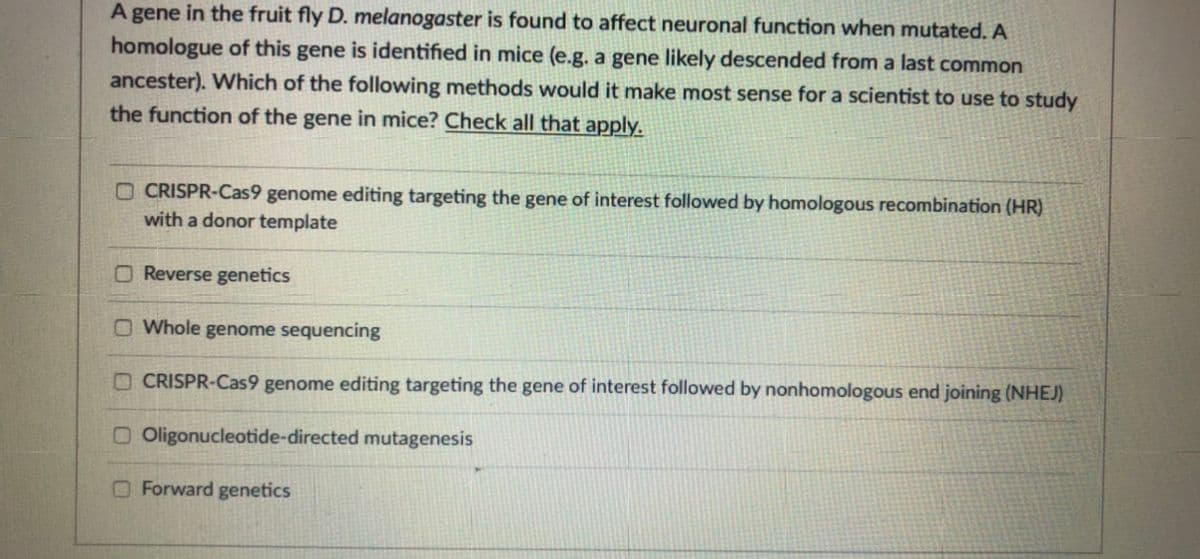A gene in the fruit fly D. melanogaster is found to affect neuronal function when mutated. A homologue of this gene is identified in mice (e.g. a gene likely descended from a last common ancester). Which of the following methods would it make most sense for a scientist to use to study the function of the gene in mice? Check all that apply. O CRISPR-Cas9 genome editing targeting the gene of interest followed by homologous recombination (HR) with a donor template O Reverse genetics O Whole genome sequencing OCRISPR-Cas9 genome editing targeting the gene of interest followed by nonhomologous end joining (NHEJ)
A gene in the fruit fly D. melanogaster is found to affect neuronal function when mutated. A homologue of this gene is identified in mice (e.g. a gene likely descended from a last common ancester). Which of the following methods would it make most sense for a scientist to use to study the function of the gene in mice? Check all that apply. O CRISPR-Cas9 genome editing targeting the gene of interest followed by homologous recombination (HR) with a donor template O Reverse genetics O Whole genome sequencing OCRISPR-Cas9 genome editing targeting the gene of interest followed by nonhomologous end joining (NHEJ)
Human Anatomy & Physiology (11th Edition)
11th Edition
ISBN:9780134580999
Author:Elaine N. Marieb, Katja N. Hoehn
Publisher:Elaine N. Marieb, Katja N. Hoehn
Chapter1: The Human Body: An Orientation
Section: Chapter Questions
Problem 1RQ: The correct sequence of levels forming the structural hierarchy is A. (a) organ, organ system,...
Related questions
Topic Video
Question

Transcribed Image Text:A gene in the fruit fly D. melanogaster is found to affect neuronal function when mutated. A
homologue of this gene is identified in mice (e.g. a gene likely descended from a last common
ancester). Which of the following methods would it make most sense for a scientist to use to study
the function of the gene in mice? Check all that apply.
O CRISPR-Cas9 genome editing targeting the gene of interest followed by homologous recombination (HR)
with a donor template
O Reverse genetics
O Whole genome sequencing
OCRISPR-Cas9 genome editing targeting the gene of interest followed by nonhomologous end joining (NHEJ)
O Oligonucleotide-directed mutagenesis
OForward genetics
Expert Solution
This question has been solved!
Explore an expertly crafted, step-by-step solution for a thorough understanding of key concepts.
This is a popular solution!
Trending now
This is a popular solution!
Step by step
Solved in 2 steps

Knowledge Booster
Learn more about
Need a deep-dive on the concept behind this application? Look no further. Learn more about this topic, biology and related others by exploring similar questions and additional content below.Recommended textbooks for you

Human Anatomy & Physiology (11th Edition)
Biology
ISBN:
9780134580999
Author:
Elaine N. Marieb, Katja N. Hoehn
Publisher:
PEARSON

Biology 2e
Biology
ISBN:
9781947172517
Author:
Matthew Douglas, Jung Choi, Mary Ann Clark
Publisher:
OpenStax

Anatomy & Physiology
Biology
ISBN:
9781259398629
Author:
McKinley, Michael P., O'loughlin, Valerie Dean, Bidle, Theresa Stouter
Publisher:
Mcgraw Hill Education,

Human Anatomy & Physiology (11th Edition)
Biology
ISBN:
9780134580999
Author:
Elaine N. Marieb, Katja N. Hoehn
Publisher:
PEARSON

Biology 2e
Biology
ISBN:
9781947172517
Author:
Matthew Douglas, Jung Choi, Mary Ann Clark
Publisher:
OpenStax

Anatomy & Physiology
Biology
ISBN:
9781259398629
Author:
McKinley, Michael P., O'loughlin, Valerie Dean, Bidle, Theresa Stouter
Publisher:
Mcgraw Hill Education,

Molecular Biology of the Cell (Sixth Edition)
Biology
ISBN:
9780815344322
Author:
Bruce Alberts, Alexander D. Johnson, Julian Lewis, David Morgan, Martin Raff, Keith Roberts, Peter Walter
Publisher:
W. W. Norton & Company

Laboratory Manual For Human Anatomy & Physiology
Biology
ISBN:
9781260159363
Author:
Martin, Terry R., Prentice-craver, Cynthia
Publisher:
McGraw-Hill Publishing Co.

Inquiry Into Life (16th Edition)
Biology
ISBN:
9781260231700
Author:
Sylvia S. Mader, Michael Windelspecht
Publisher:
McGraw Hill Education